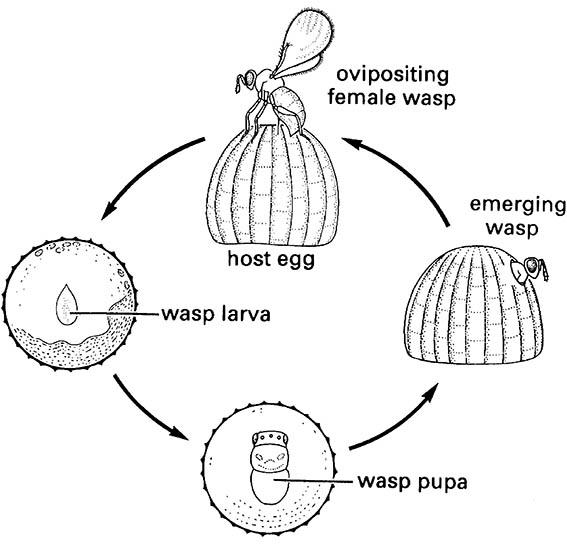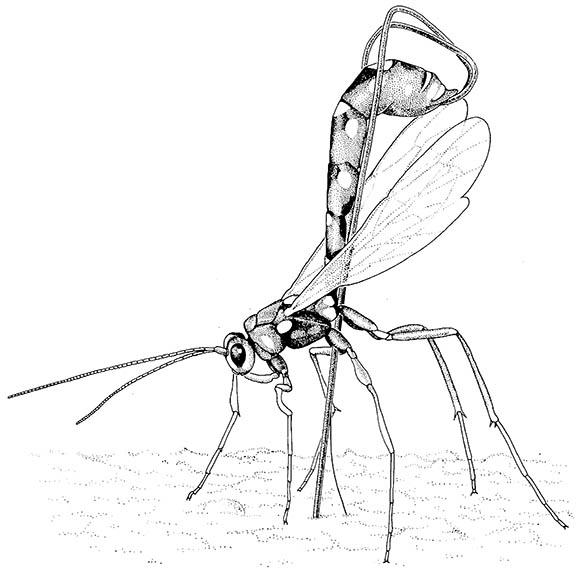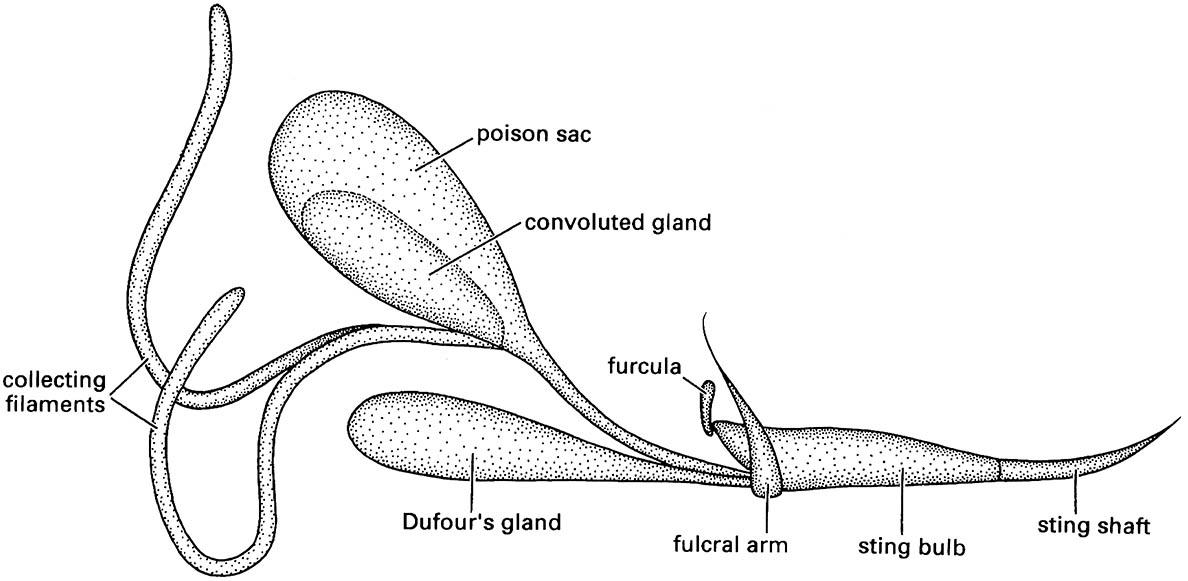Box 12.2. Hymenoptera (bees, ants, wasps, sawflies, and wood wasps)
The Hymenoptera is an order of about 100,000 described species of holometabolous neopterans, classified traditionally in two suborders, the “Symphyta” (wood wasps and sawflies) (which is a paraphyletic group) and Apocrita (wasps, bees, and ants). Within the Apocrita, the aculeate taxa (Chrysidoidea, Vespoidea, and Apoidea) form a monophyletic group (Fig. 12.2) characterized by the use of the ovipositor for stinging prey or enemies rather than for egg-laying. Adult hymenopterans range in size from minute (e.g. Trichogrammatidae, Fig. 16.3) to large (i.e. 0.15–120 mm long), and from slender (e.g. many Ichneumonidae) to robust (e.g. the bumble bee, Fig. 12.3). The head is hypognathous or prognathous, and the mouthparts range from generalized mandibulate to sucking and chewing, with mandibles in Apocrita often used for killing and handling prey, defense, and nest building. The compound eyes are often large; ocelli may be present, reduced, or absent. The antennae are long, multisegmented, and often prominently held forwardly or recurved dorsally. In Symphyta there are three conventional segments in the thorax, but in Apocrita the first abdominal segment (propodeum) is included in the thoracic tagma, which is then called a mesosoma (or in ants, alitrunk) (as illustrated for workers of the wasp Vespula germanica and a Formica ant). The wings have reduced venation, and the hind wings have rows of hooks (hamuli) along the leading edge that couple with the hind margin of the fore wing in flight. Abdominal segment 2 (and sometimes also 3) of Apocrita forms a constriction, or petiole, followed by the remainder of the abdomen, or gaster. The female genitalia include an ovipositor, comprising three valves and two major basal sclerites, which may be long and highly mobile allowing the valves to be directed vertically between the legs (Fig. 5.11). The ovipositor of aculeate Hymenoptera is modified as a sting associated with venom apparatus (Fig. 14.11).
The eggs of endoparasitic species are often deficient in yolk, and sometimes each may give rise to more than one individual (polyembryony; section 5.10.3). Symphytan larvae are eruciform (caterpillar-like) (Fig. 6.6c) with three pairs of thoracic legs with apical claws and some abdominal legs; most are phytophagous. Apocritan larvae are apodous (Fig. 6.6i), with the head capsule frequently reduced but with prominent strong mandibles; the larvae may vary greatly in morphology during development (heteromorphosis). Apocritan larvae have diverse feeding habits and may be parasitic (section 13.3.1), gall forming, or be fed with prey or nectar and pollen by their parent (or, if a social species, by other colony members). Adult hymenopterans mostly feed on nectar or honeydew, and sometimes drink hemolymph of other insects; only a few consume other insects.
Haplodiploidy allows a reproductive female to control the sex of offspring according to whether the egg is fertilized or not. Possible high relatedness amongst aggregated individuals facilitates well-developed social behaviors in many aculeate Hymenoptera.
For phylogenetic relationships of the Hymenoptera see section 7.4.2 and Figs. 7.2 and 12.2.


The superfamily Apoidea includes the Sphecidae sensu stricto, the Crabronidae (formerly part of a broader Sphecidae), the Ampulicidae (not shown), and all bees, here treated as one family, the Apidae, with several subfamilies (e.g. Apinae, Colletinae, Halictinae; not all solitary groups are shown) of uncertain relationships. Traditionally, bees have been classified in several families, a ranking that is unjustified phylogenetically. Probable relationships within non-social aculeate wasps (e.g. Ampulicidae, Pompilidae, and Rhopalosomatidae) and bees are not depicted. (Adapted from several sources including Gauld & Bolton 1988; Alexander 1992; Brothers 1999; B.N. Danforth, pers. comm.)

A tiny female wasp of a Trichogramma species (Hymenoptera: Trichogrammatidae) oviposits into a lepidopteran egg; the wasp larva develops within the host egg, pupates, and emerges as an adult, often with the full life cycle taking only one week. (After van den Bosch & Hagen 1966)

(After various sources, especially Michener 1974)

If a larva is located, she stings and paralyses it before laying an egg on it.

(After Hermann & Blum 1981)

(a) Lepidoptera: Sphingidae; (b) Lepidoptera: Geometridae; (c) Hymenoptera: Diprionidae. Oligopod larvae: (d) Neuroptera: Osmylidae; (e) Coleoptera: Carabidae; (f ) Coleoptera: Scarabaeidae. Apod larvae: (g) Coleoptera: Scolytidae; (h) Diptera: Calliphoridae; (i) Hymenoptera: Vespidae. ((a, e-g) After Chu 1949; (b, c) after Borror et al. 1989; (h) after Ferrar 1987; (i) after CSIRO 1970)

Broken lines indicate uncertain relationships. Thysanura sensu lato refers to Thysanura in the broad sense. (Data from several sources)



